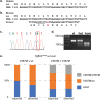Genetic analysis and functional assessment of a TGFBR2 variant in micrognathia and cleft palate
- PMID: 40489498
- PMCID: PMC12148102
- DOI: 10.1371/journal.pone.0324803
Genetic analysis and functional assessment of a TGFBR2 variant in micrognathia and cleft palate
Abstract
Cleft lip and cleft palate are among the most common congenital anomalies and are the result of incomplete fusion of embryonic craniofacial processes or palatal shelves, respectively. We know that genetics play a large role in these anomalies but the list of known causal genes is far from complete. As part of a larger sequencing effort of patients with congenital craniofacial anomalies, we identified a rare candidate variant in transforming growth factor beta receptor 2 (TGFBR2). This variant alters a highly conserved amino acid and is predicted to be pathogenic by a number of metrics. The family history and population genetics suggest that this specific variant would be incompletely penetrant, but this gene has been convincingly implicated in craniofacial development. In order to test the hypothesis this might be a causal variant, we used genome editing to create the orthologous variant in a new mouse model. Surprisingly, Tgfbr2V387M mice did not exhibit craniofacial anomalies or have reduced survival, suggesting Tgfbr2V387M is not a causal variant for cleft palate/ micrognathia. The discrepancy between in silico predictions and mouse phenotypes highlights the complexity of translating human genetic findings to mouse models. We expect these findings will aid in interpretation of future variants seen in TGFBR2 from ongoing sequencing of patients with congenital craniofacial anomalies.
Copyright: © 2025 Michaels et al. This is an open access article distributed under the terms of the Creative Commons Attribution License, which permits unrestricted use, distribution, and reproduction in any medium, provided the original author and source are credited.
Conflict of interest statement
The authors have declared that no competing interests exist.
Figures




Update of
-
Genetic Analysis and Functional Assessment of a TGFBR2 Variant in Micrognathia and Cleft Palate.bioRxiv [Preprint]. 2024 Apr 11:2024.04.08.588524. doi: 10.1101/2024.04.08.588524. bioRxiv. 2024. Update in: PLoS One. 2025 Jun 9;20(6):e0324803. doi: 10.1371/journal.pone.0324803. PMID: 38645005 Free PMC article. Updated. Preprint.
References
-
- Schutte BC, et al. Irf6-related disorders. In: Adam MP, editor. GeneReviews. Seattle (WA): University of Washington; 1993.
MeSH terms
Substances
Grants and funding
LinkOut - more resources
Full Text Sources
Medical
Molecular Biology Databases
Research Materials

